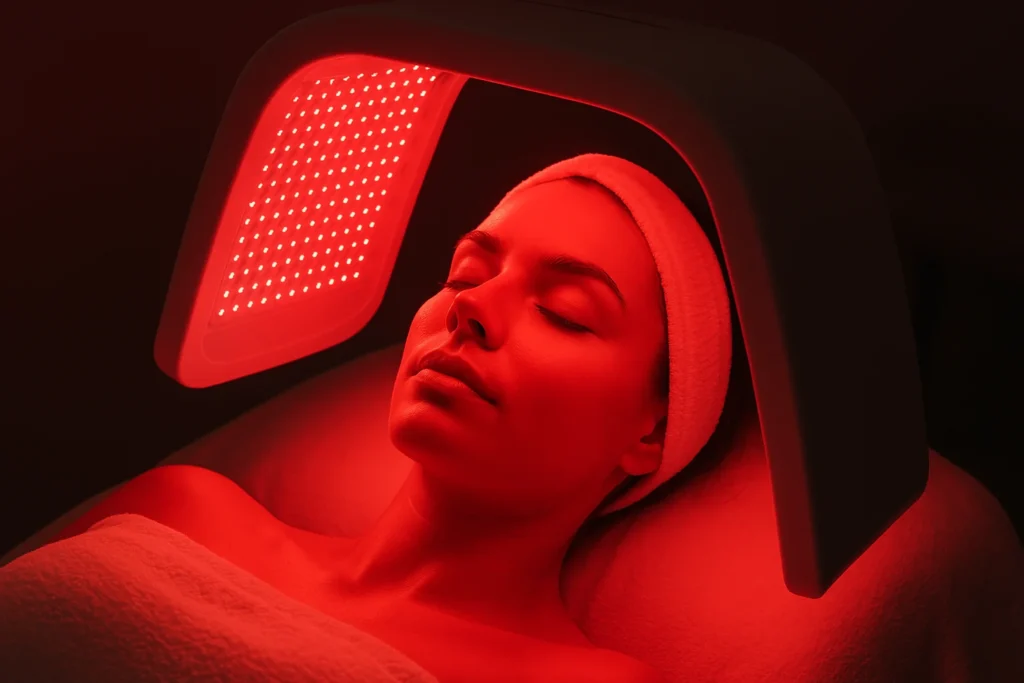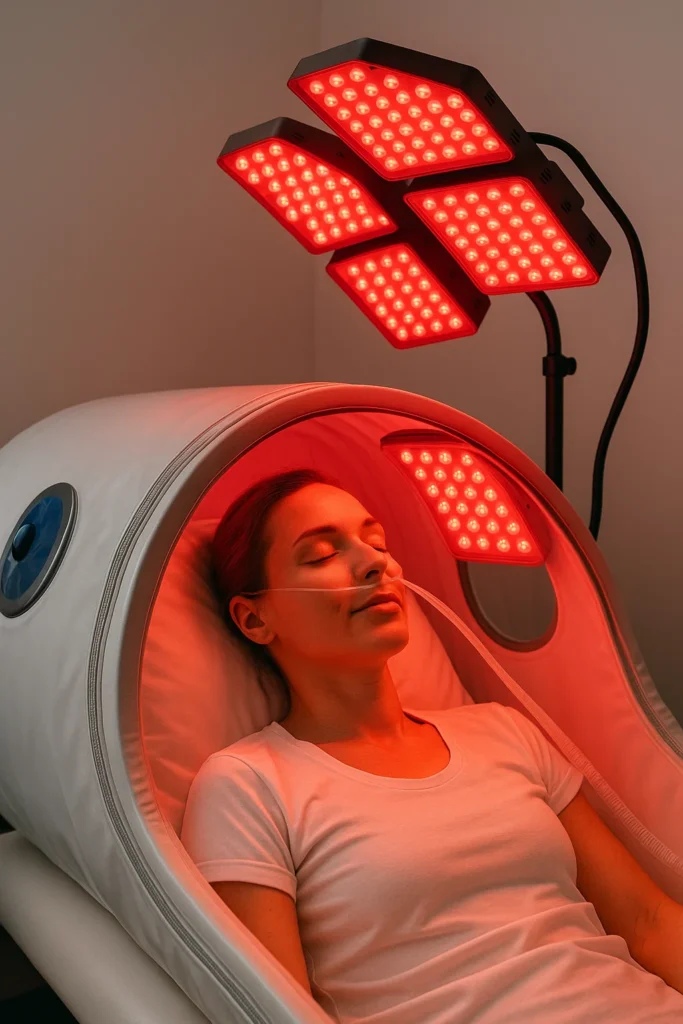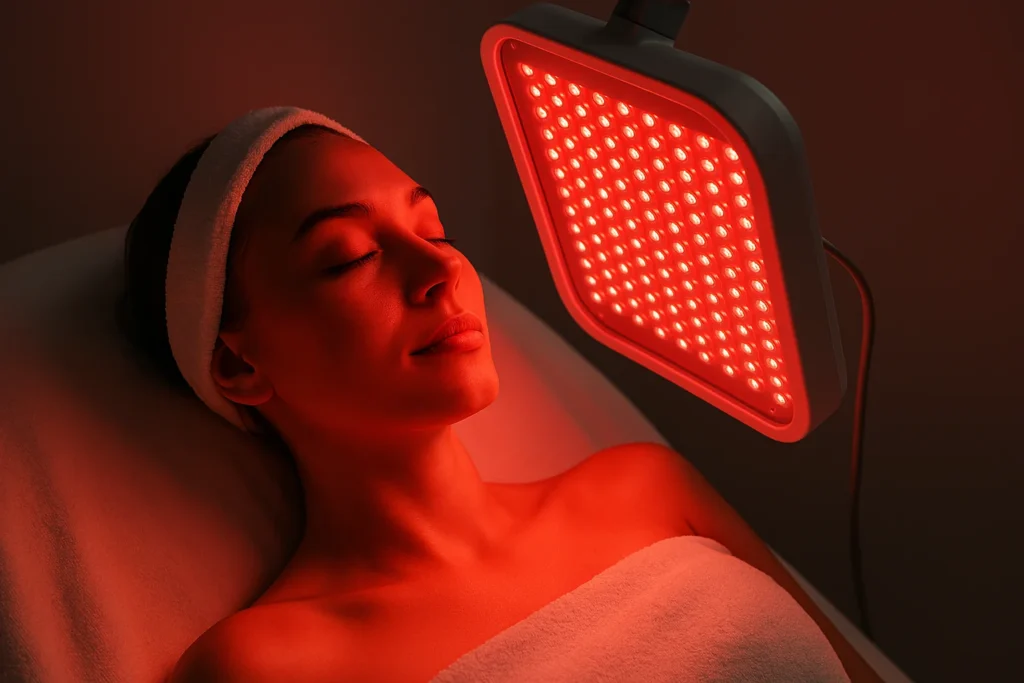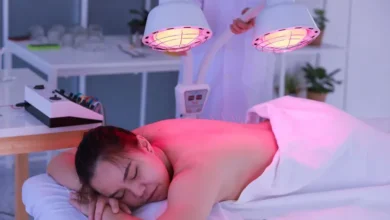What Is Red Light Therapy? A Detailed Beginner’s Guide!
Introduction to Red Light Therapy!
Red Light Therapy (RLT) is a revolutionary, noninvasive treatment that uses low-wavelength red light to stimulate the body’s natural healing processes. You’ve probably heard of it in skincare circles, fitness centers, or even your dermatologist’s office. But here’s the deal—it’s not just a trend. RLT has been studied for decades, and science increasingly backs its therapeutic effects on everything from skin rejuvenation to muscle repair and mood improvement.
So, what makes red light different from any other light? Unlike ultraviolet (UV) rays from the sun that damage your skin, red light penetrates deeper without harming tissue. It stimulates your mitochondria. This boosts healing, reduces inflammation, and revs up regeneration at the cellular level—no chemicals, no cutting, no needles—just light.
Red light is typically used in devices like LED panels, laser machines, and handheld wands. Whether targeting wrinkles, recovering from a challenging workout, or just looking for a way to feel better overall, RLT could be the natural solution you didn’t know you needed.

Brief History and Origins of RLT!
The roots of red light therapy stretch back to the early 1900s when Danish physician Niels Ryberg Finsen won the Nobel Prize for using light therapy to treat lupus vulgaris, a skin condition caused by tuberculosis. But it wasn’t until the 1960s that red light therapy started gaining momentum.
In 1967, Hungarian scientist Endre Mester discovered the wound-healing power of red light while experimenting with lasers on mice. The mice exposed to red light regrew shaved hair faster and improved tissue healing. This accidental discovery laid the foundation for modern-day photobiomodulation, a fancy word for using light to change biological processes.
Fast-forward to today—RLT is used in medical clinics, skin care spas, and homes worldwide. From NASA’s research on astronaut health to pro athletes’ use of it for muscle recovery, red light therapy has come a long way from its humble beginnings. And it’s just getting started.
The Science Behind Red Light Therapy. How Red Light Therapy Works at a Cellular Level!
Red light therapy isn’t magic—it’s biology. When red and near-infrared light (typically 600–850 nanometers) hits your skin, it doesn’t just stop at the surface. It penetrates through layers of skin and even into muscle tissue. Once there, it targets your mitochondria.
Mitochondria absorb red light like solar panels, soaking up sunlight. This stimulation helps the mitochondria produce more adenosine triphosphate (ATP), which is cellular energy. The more ATP your cells have, the more efficiently they function, repairing skin, reducing inflammation, or speeding up recovery after a workout.
Think of RLT as a tune-up for your cells. It boosts circulation, supports detoxification, and helps tissues regenerate faster. Because the process is natural, your body does all the heavy lifting. Red light gives it the power to perform better, heal faster, and age more slowly.
The Role of Mitochondria and ATP Production!
Let’s get nerdy for a second. Every cell in your body is like a tiny factory, and the mitochondria are the engines that keep the factory running. They take nutrients and oxygen and turn them into ATP, which powers almost every process in your body—movement, repair, growth, and even thinking.
Imagine your cellular engine is running on low power because of stress, aging, or illness. That’s where red light therapy comes in. By stimulating mitochondria with specific wavelengths of red and near-infrared light, RLT helps your cells produce more ATP. More energy means better performance and faster healing.
The improved mitochondrial function triggered by RLT has wide-reaching benefits. Studies have shown enhanced collagen production, reduced oxidative stress, lower inflammation, and faster muscle regeneration. RLT supercharges your cells, and so do you when your cells function better.
Types of Red Light Therapy Devices. At-Home Devices vs. Professional-Grade Devices!
Red light therapy isn’t just reserved for fancy medical clinics anymore. With the rise in popularity, various devices are now available for home use. But how do they compare to what the pros use?
Professional-grade devices, like those found in dermatology offices or sports medicine clinics, typically offer more vigorous light intensity and cover larger surface areas. They’re designed for quicker sessions and often have customizable settings to treat specific conditions more effectively.
On the flip side, at-home devices are more affordable, user-friendly, and convenient. They include handheld wands, facial masks, and LED panels. While they may not be as powerful, they can still deliver results with consistent use. The key? Patience and consistency. Home devices are best for ongoing maintenance and preventative care, while professional treatments are ideal for more intensive therapy.
Regardless of where you use it, the effectiveness of red light therapy boils down to light intensity (measured in mW/cm²), wavelength, and treatment time. Do your research before buying a device because not everyone is equal.
Different Light Wavelengths and What They Mean!
Red light therapy isn’t just about “red” light. It covers a spectrum of wavelengths, including visible red light and invisible near-infrared (NIR) light. Each wavelength penetrates the body differently and has unique therapeutic benefits.
Red Light (620–700 nm) is best for surface-level treatments such as skin rejuvenation, acne reduction, and collagen production.
Near-infrared light (700–850 nm) Penetrates deeper into muscles, joints, and even bones. It is ideal for pain relief, injury recovery, and inflammation.
Some advanced RLT devices combine red and NIR light for a full-spectrum treatment. This combination provides comprehensive healing, addressing surface and deeper tissues in one session. So, when choosing a device, look for one that offers multiple wavelengths for maximum benefits.
Health and Wellness Benefits of Red Light Therapy. Skin Health and Anti-Ageing Effects!
Let’s be honest—we’re all chasing that youthful glow. And that’s precisely where red light therapy shines, literally. It’s like giving your skin a direct line to the fountain of youth, minus the injections or expensive creams. RLT helps increase blood circulation, boost collagen production, and accelerate cell regeneration—all critical for maintaining smooth, firm, and radiant skin.
Collagen, the protein responsible for skin elasticity and firmness, tends to decrease as we age, leading to sagging, wrinkles, and fine lines. Red light therapy stimulates fibroblasts in your skin to produce more collagen and elastin. Over time, this results in a noticeable reduction in wrinkles, crow’s feet, and sagging.
But RLT doesn’t stop at aging. It also helps reduce redness, improve skin tone, and shrink pores. And for people struggling with hyperpigmentation or sun damage, it can gradually lighten those dark spots. Many users report a more even complexion and better skin texture within just a few weeks of regular use.
RLT is also gentle. Unlike lasers or chemical peels, there’s no downtime, peeling, or irritation. It’s safe for all skin types and can be used year-round. Whether you’re looking to age gracefully or boost your skincare routine, red light therapy delivers real, visible results.
Muscle Recovery and Athletic Performance!
Athletes, fitness enthusiasts, and weekend warriors are turning to red light therapy to supercharge their recovery and performance. Why? Because it works. Red light therapy reduces muscle soreness, accelerates healing, and enhances endurance without supplements or pharmaceuticals.
When you exercise, tiny tears form in your muscle fibers. This is normal and part of building strength. But the soreness that follows? Not so much fun. Red light therapy speeds up the repair process by increasing ATP production and improving blood flow. That means less downtime between workouts and a faster return to peak performance.
Studies have shown that using RLT before a workout can enhance muscle endurance, while post-exercise sessions help with faster recovery and reduced inflammation. It also helps flush out lactic acid, the compound responsible for that burning sensation in overworked muscles.
Many professional athletes—think NBA stars, Olympians, and UFC fighters—swear by red light therapy. But you don’t need to be a pro to benefit. Whether lifting weights, running marathons, or just trying to stay active, RLT can help you train harder and recover smarter.
Joint Pain and Inflammation Relief!
Chronic joint pain can be life-altering. Whether it’s from arthritis, an old injury, or everyday wear and tear, the discomfort can make even simple tasks a struggle. That’s where red light therapy comes in. With its potent anti-inflammatory effects, RLT offers a drug-free, noninvasive solution for relieving joint pain and stiffness.
When red and near-infrared light penetrates the skin, it increases circulation and oxygenation in the affected area. This not only reduces inflammation but also encourages tissue regeneration and cartilage repair. The result? Less pain, better mobility, and improved joint function.
Several clinical trials have demonstrated the effectiveness of red light therapy for conditions like osteoarthritis, rheumatoid arthritis, and tendonitis. Patients report less swelling, greater range of motion, and an overall improvement in quality of life.
Because RLT doesn’t involve medication, it’s an excellent option for those who can’t take NSAIDs or want to avoid potential side effects. Whether you’re dealing with knee pain, shoulder stiffness, or general joint discomfort, red light therapy can help you get moving again without the pills.
Mental Health and Cognitive Function!
Red light therapy is good for your body and a game, but it is also good for your brain. Research shows that RLT can positively impact mental health, cognitive performance, and emotional well-being.
So, how does shining a red light on your head make you feel better? It’s all about blood flow and mitochondrial function. Near-infrared light penetrates the skull and boosts brain circulation, enhancing oxygen delivery and cellular energy production. This increased ATP production supports better neural communication and brain function.
For people struggling with depression, anxiety, or brain fog, red light therapy offers a promising alternative or complementary treatment. It helps balance mood-regulating neurotransmitters and reduces inflammation in brain tissues, which play key roles in mental health.
Some studies have even linked red light therapy to memory, focus, and cognitive speed improvements, especially in older adults or individuals with neurodegenerative conditions. It’s being explored as a potential treatment for Alzheimer’s, dementia, and traumatic brain injuries.
If you’re feeling mentally drained, anxious, or just not as sharp as you used to be, red light therapy might be the mental recharge you need. It’s like a power nap for your neurons—safe, natural, and incredibly effective.

Red Light Therapy for Skin Conditions (Acne, Rosacea, and Psoriasis Treatment)!
Red light therapy could be your new best friend if you’re tired of battling breakouts or chronic skin conditions. It’s gentle enough for daily use but powerful enough to tackle challenging skin issues like acne, rosacea, and psoriasis.
For acne, red light therapy works by reducing inflammation and calming the skin, helping to prevent clogged pores and reduce redness. Combined with blue light therapy (which targets acne-causing bacteria), it offers a one-two punch that clears up skin without drying it out or causing irritation like harsh topical treatments.
Rosacea sufferers also benefit from RLT thanks to its anti-inflammatory and circulation-boosting effects. Over time, it helps tone down facial redness and soothe sensitive skin. And because it doesn’t heat the skin like lasers, there’s minimal risk of flare-ups.
Psoriasis, a chronic autoimmune condition that causes thick, scaly patches on the skin, can also improve with regular red light therapy. The light slows down the overproduction of skin cells and reduces inflammation, leading to smoother skin and fewer flare-ups.
The best part? It requires no prescriptions, chemicals, or downtime. It is a consistent, natural solution that can help you regain control of your skin and confidence.
Wound Healing and Scar Reduction!
Red light therapy has impressive regenerative properties, making it a powerful tool for wound healing and scar reduction. Whether it’s a surgical scar, burn, or everyday cut, RLT can accelerate tissue repair and minimize long-term damage.
When applied to a wound, red light therapy increases blood flow and stimulates fibroblasts, the cells responsible for producing collagen and elastin. This speeds up the healing process and reduces the risk of infection or complications. It also enhances the formation of new capillaries, which helps bring nutrients and oxygen to the area.
RLT breaks down excess collagen for scars, leading to raised or discolored tissue. Over time, this promotes smoother, more even skin tone and texture. It’s particularly effective when used early in the healing process but can also improve the appearance of older scars.
Hospitals and burn units have even adopted red light therapy to treat chronic wounds and ulcers in diabetic or bedridden patients. It’s non-invasive, pain-free, and highly effective. Whether recovering from surgery or dealing with lingering scars, RLT can help your skin bounce back faster and better.
Safety and Side Effects of Red Light Therapy. Is Red Light Therapy Safe?
One of the most appealing aspects of red light therapy is its excellent safety profile. Whether using it at home or receiving professional treatments, RLT is generally considered safe for most people, with minimal risks or adverse effects. Its noninvasive nature makes it a preferred alternative to more aggressive treatments like chemical peels, injections, or pharmaceuticals.
The FDA has approved red light therapy for various uses, including wound healing and cosmetic applications. Unlike UV rays from the sun, red and near-infrared light do not damage skin or tissues. Instead, they stimulate beneficial biological responses without generating heat or harming DNA.
That said, it’s always smart to exercise caution. People with light sensitivity disorders, photosensitizing medications, or underlying medical conditions should consult a healthcare provider before beginning RLT. Additionally, pregnant women and individuals with active cancer should avoid RLT unless cleared by a doctor.
Red light therapy is one of the safest therapeutic tools available today when used at the right intensity, duration, and frequency. Because it requires no downtime or recovery, it’s perfect for integrating into your daily wellness routine without disruption.
Potential Side Effects and Contraindications!
While red light therapy is safe, it’s not entirely without potential side effects. The most commonly reported issue is temporary skin redness or irritation, typically from overexposure or using a device with too high an intensity. These effects are usually mild and resolve quickly on their own.
In rare cases, individuals might experience eye strain or sensitivity if the light is too bright and proper eye protection isn’t used. This is especially important for high-powered devices and facial treatments. Wearing protective goggles can eliminate this risk.
Other potential—but uncommon—side effects include headaches, dizziness, or mild fatigue after a session. These symptoms are often linked to overstimulation and usually subside quickly.
Red light therapy should be avoided or used with caution in the following scenarios:
- If you’re taking medications that increase photosensitivity (e.g., tetracycline, retinoids)
- If you have a history of seizures triggered by light
- If you are currently undergoing cancer treatment or have active tumors
- If you’re pregnant and haven’t been cleared by your doctor
As with any therapy, start slow, follow manufacturer guidelines, and pay attention to how your body responds. A little awareness goes a long way in ensuring a safe and practical experience.
How to Use Red Light Therapy. Frequency and Duration of Sessions!

To get the most out of red light therapy, consistency is key. But how often should you use it? And for how long? The answer depends on your goals, the type of device you’re using, and your body’s response.
For general skin health or anti-aging:
- Start with 3–5 weekly sessions, each lasting about 10–20 minutes.
- After 4–6 weeks, reduce frequency to 2–3 times per week for maintenance.
For muscle recovery or joint pain:
- Daily sessions of 15–30 minutes may be necessary for acute issues.
- Once symptoms improve, you can scale back to a few weekly sessions.
- For mental health and cognitive function:
- 3–4 sessions a week using a near-infrared headband or panel can provide benefits.
- Sessions should be kept between 10 and 20 minutes.
Always follow the manufacturer’s instructions for your specific device. Overuse doesn’t necessarily mean better results and can lead to diminishing returns or mild irritation. Think of it like working out: more isn’t always better, but regularity leads to long-term improvements.
It’s also smart to track your progress. Take weekly photos or journal symptoms to observe subtle changes over time. RLT is a gradual process; noticeable improvements typically appear within 3–6 weeks of consistent use.
Best Practices for Optimal Results!
To maximize your results with red light therapy, there are a few best practices that can make a big difference:
- Use Clean, Bare Skin: Remove makeup, lotions, or sunscreen before treatment. Clean skin allows for better light penetration.
- Keep the Device Close: Position your device 6–12 inches from your skin, depending on its strength. Closer contact means deeper penetration.
- Stay Still: Stay as still as possible during your session so the light evenly hits the target area.
- Hydrate: Red light therapy boosts circulation and detoxification, so drink water before and after to support your body’s healing response.
- Protect Your Eyes: Use goggles or keep your eyes closed if you’re using high-intensity lights, especially near the face.
- Be Consistent: Set a schedule. Like brushing your teeth, the best results come from making RLT part of your routine.
- Pair with Healthy Habits: While RLT is powerful, pairing it with healthy eating, exercise, and proper sleep amplifies the benefits.
By following these tips, you’ll set yourself up for the best possible outcomes—whether you’re aiming to reduce wrinkles, recover faster from workouts, or feel better every day.
Choosing the Right Red Light Therapy Device. Key Features to Look for in a Device!
Not all red light therapy devices are created equal, and with so many options on the market, it can be overwhelming to choose the right one.
Here are the top features to look for when shopping for a quality device:
- Wavelength Range: For the most comprehensive benefits, look for devices offering both red light (620–700 nm) and near-infrared light (700–850 nm).
- Irradiance (Power Output): A good device should deliver at least 20–40 mW/cm². Higher irradiance leads to deeper penetration and faster results.
- Treatment Area: Larger panels cover more skin in less time, while handheld devices are better for targeted treatments.
- Session Timer: Built-in timers help ensure you use the device correctly without overexposing the skin.
- Safety Certifications: Look for FDA-cleared or medically certified devices to ensure quality and safety.
- Cooling System: Devices with internal cooling systems maintain a safe temperature during use, increasing comfort.
Buying a red light device is an investment in your health. Choose wisely, and you’ll enjoy years of benefits from a high-quality product.
Recommended Brands and Products!
Here are some of the top-rated red light therapy brands and devices for different budgets and needs:
- Joovv Solo 3.0: Ideal for full-body therapy with clinical-grade power and dual wavelengths.
- Mito Red Light MitoPRO Series: Offers excellent power and value and is suitable for serious users.
- PlatinumLED BIO Series: Known for high irradiance and affordability, it is excellent for home users.
- Hooga HG300: Budget-friendly, compact panel for beginners.
- CurrentBody Skin LED Mask – Designed for facial skin rejuvenation with red and near-infrared light.
Each device has pros and cons, so consider your goals, space, and budget before purchasing. Check online reviews, warranty policies, and customer support—those can make a big difference in your overall experience.
Red Light Therapy vs. Other Light-Based Therapies. RLT vs. Blue Light Therapy!
While red and blue light therapy uses specific wavelengths to achieve therapeutic results, they serve different purposes. Understanding the key differences can help you choose the proper treatment or combine them for better results.
Red Light Therapy (RLT) uses wavelengths between 620–850 nm. It penetrates deep into the skin and underlying tissues, stimulating collagen production, reducing inflammation, and promoting cellular repair.
It’s best used for:
- Anti-aging and wrinkle reduction
- Muscle and joint pain relief
- Wound healing and scar reduction
- Boosting overall skin health and circulation
Blue Light Therapy, on the other hand, typically uses wavelengths around 415–495 nm. It doesn’t penetrate as deeply and is mainly effective on the skin’s surface.
Its primary benefit is antimicrobial—it kills acne-causing bacteria (P. acnes), making it ideal for:
- Treating mild to moderate acne
- Reducing oil production
- Minimising acne-related inflammation
In many skincare clinics, both therapies are used together. Blue light targets the root cause of acne, while red light calms the skin and speeds healing. This combination therapy can yield faster, more comprehensive results, especially for people dealing with chronic breakouts.
Ultimately, if you’re after muscle recovery, anti-aging, or pain relief, RLT is your go-to. If your primary concern is acne or bacterial skin issues, blue light therapy might be a better fit or a great addition.
RLT vs. Infrared Light Therapy!
Another standard comparison is between red light and infrared (IR) therapy. While the two are often mentioned together, they operate at different wavelengths and offer other benefits.
Red Light Therapy falls within the visible light spectrum (around 620–700 nm). It works best for surface-level treatments such as:
- Enhancing skin tone
- Reducing fine lines
- Improving wound healing
Infrared Light Therapy, especially near-infrared (NIR), operates between 700–1100 nm and is invisible to the naked eye.
It penetrates the body, reaching muscles, joints, and even bones. This makes it highly effective for:
- Deep tissue repair
- Joint pain and arthritis
- Muscle recovery
- Increasing blood flow and reducing inflammation
Most modern RLT devices combine red and near-infrared light, giving users the best of both worlds. Red light alone may be enough if you only target cosmetic issues like wrinkles. However, a mixed red and NIR light will deliver more noticeable pain, inflammation, or athletic recovery results.

Real-Life Success Stories and Testimonials. Before-and-After Experiences!
Real people are seeing real results with red light therapy. Stories speak louder than any clinical study. From dramatic skin transformations to life-changing pain relief, testimonials across the web paint a vivid picture of what RLT can achieve.
Take Sarah, a 35-year-old mom who struggled with adult acne and scarring. After using a red light facial mask five times a week for three months, she noticed a dramatic reduction in breakouts and faded dark spots. “I’ve spent hundreds on skincare, but nothing has worked like this,” she says.
Then there’s Mike, a 50-year-old who used red light therapy for chronic knee pain. After years of discomfort and limited mobility, he began daily 20-minute sessions with a red/NIR light panel. Within two weeks, I could walk without limping. It’s the first real relief I’ve had in years,” he explains.
Athletes also rave about RLT’s performance-boosting effects. One marathon runner used it daily during training season to help prevent injuries and reduce muscle fatigue. Her times improved, and she could train harder with fewer rest days.
Thousands of online reviews, Reddit threads, and social media posts back these stories. The bottom line? People see tangible, measurable, and often life-enhancing results with consistent use of red light therapy.
Expert Opinions and Reviews!
Doctors, dermatologists, chiropractors, and fitness experts increasingly recommend red light therapy to their patients and clients. Why? Because it offers results without side effects.
Dr. Whitney Bowe, a leading NYC dermatologist, says red light therapy “stimulates fibroblasts, reduces inflammation, and improves circulation,” making it ideal for skin rejuvenation and acne treatment. Chiropractors often use red/NIR panels for pain management and tissue recovery plans for back pain and joint conditions.
Fitness influencers and biohackers like Ben Greenfield and Dave Asprey are vocal advocates. They praise red light for its energy-boosting and anti-inflammatory benefits. “It’s like giving your cells a double espresso,” Asprey once joked on his podcast.
Independent reviewers also point out the benefits. Tech sites frequently evaluate home-use panels and masks, offering side-by-side comparisons. The consensus? A high-quality red light device consistently provides serious value and noticeable improvements over time.
The Future of Red Light Therapy. Emerging Trends and Innovations!
As the demand for noninvasive health solutions grows, red light therapy is evolving quickly. New technologies, more innovative devices, and integrated apps are making it easier than ever to incorporate professional-grade RLT into daily life.
One trend is wearable red light therapy—from light therapy caps for hair regrowth to flexible pads that wrap around joints or muscles. These portable devices allow users to multitask while receiving treatment, making the therapy more convenient and accessible.
Another innovation is smart app integration. Some RLT panels connect to your phone via Bluetooth, allowing you to customize session lengths, wavelengths, and intensity settings. You can even track progress over time, ideal for people with long-term health or beauty goals.
Clinical-grade RLT is also being explored in cutting-edge medical research. Trials are investigating its use in Alzheimer’s, Parkinson’s, traumatic brain injury (TBI), and even cancer support. As more data emerges, red light therapy may become a staple in conventional and holistic treatment plans.
Expect even more specialized tools, such as apps with zone-specific settings or red-light toothbrushes to improve gum health. The future of RLT looks bright—literally and figuratively.
Clinical Studies and Ongoing Research!
Scientific research into red light therapy is expanding rapidly. Universities and hospitals worldwide are conducting studies to validate RLT’s impact on various conditions.
Some of the most exciting clinical applications include:
- Neuroprotection: Studies on NIR light improving cognitive function and reducing neuroinflammation in Alzheimer’s patients.
- Wound healing: Trials showing faster recovery in diabetic ulcers and surgical wounds with red light.
- Hair regrowth: Multiple trials confirm significant hair density and thickness improvement in people with androgenetic alopecia.
- Sports medicine: Ongoing research shows that RLT enhances muscle performance and reduces post-exercise soreness.
- Peer-reviewed journals: Including Photomedicine and Laser Surgery and Lasers in Surgery and Medicine, have published hundreds of articles highlighting the safety, efficacy, and mechanisms of RLT.
This growing body of evidence is pushing red light therapy into the mainstream, and soon, it will become a standard recommendation for many health and wellness protocols.
Conclusion
Red light therapy is more than a wellness fad—it’s a scientifically backed, versatile, and powerful tool for improving your health from the inside out. Whether you’re looking to rejuvenate your skin, relieve chronic pain, recover faster from workouts, or enhance your mental clarity, RLT offers real, measurable benefits without the downsides of invasive procedures or pharmaceuticals.
From the cellular level to full-body wellness, red light therapy harnesses the healing power of light to recharge your life. With the correct device, consistency, and a little patience, you can experience noticeable improvements in how you look, feel, and perform.
So, if you’re unsure about trying it, consider this your green light. Start small, stay consistent, and watch the transformation unfold.
FAQs
How soon will I see results from red light therapy?
Most people notice visible results within 2–4 weeks of consistent use, especially for skin-related issues. Deeper conditions like joint pain or inflammation may take longer, typically around 4–8 weeks.
Can I use red light therapy every day?
Yes, daily use is generally safe and can even accelerate results. Just follow the recommended session times and allow your body to adapt. For long-term use, 3–5 times a week is often sufficient.
Does red light therapy work for hair loss?
Studies have shown that red and near-infrared light can stimulate hair follicles, increase blood flow to the scalp, and promote new growth in androgenetic alopecia or thinning hair cases.
Can you overdo red light therapy?
While RLT is safe, excessive use can lead to skin irritation or diminished results. Stick to manufacturer guidelines and avoid sessions longer than 30 minutes in a single area unless instructed by a professional.
Is red light therapy FDA-approved?
Many red light therapy devices are FDA-cleared for specific uses, such as wrinkle reduction, acne treatment, and pain relief. Always look for devices with FDA clearance to ensure quality and safety.



